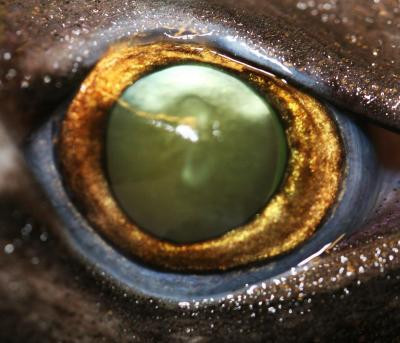Glow-in-the-Dark Sharks' Eyes Evolved to See in Ocean's Twilight Zone

Unusual glowing sharks have evolved eyes that are adapted to see complex patterns of light in the dark "twilight zone" of the deep ocean, according to new research.
These bioluminescent "glowing" sharks have a higher density of light-sensitive cells in their retinas, compared to non-bioluminescent species.
Some sharks have even developed other visual adaptations that help them see the glimmering lights they use to signal to each other, find prey and camouflage themselves in areas of the ocean where little light penetrates.
"There are about 50 different shark species that are able to produce light — about 10% of all currently known sharks," lead researcher Julien Claes, of the Catholic University of Louvain in Belgium, told NBC.
The mesopelagic twilight zone, between 200 to 1000m deep in the sea, is a vast and dark habitat. In deeper water, the sunlight is progressively replaced by bioluminescent light by a living organism.
To better understand the glowing predators in this zone, the researchers analysed the eye shape, structure and retinal cell mapping in the visual systems of five deep-sea bioluminescent sharks.

Four lantern sharks, and one kitefin shark, listed as Near Threatened by the International Union for Conservation of Nature, were studied.
The team discovered that the eyes of the sharks contained a translucent area in the upper eye orbit of the lantern sharks, which could help adjust counter-illumination or aid in using bioluminescence to camoflage the creature.
According to the researchers, these clear patches could help the shark gauge the type and amount of light filtering into the dark.
They are then able to match the light they produce to their surroundings, a type of camoflage called counterillumination, which prevents animals from standing out as darker silhouettes when viewed from below.
A gap between the lens and the iris was also found, which allows extra light to the retina — a new finding in the study of sharks.
Claes told LiveScience that he also discovered some species have "light-saber" spines to ward off predators.
Compared to previous studies on non-bioluminescent sharks, the glowing species have higher rod densities in the eyes, which could provide them with improved temporal resolution. This is useful for bioluminescent communication during social interactions.
"Every bioluminescent signal needs to reach a target photoreceptor to be ecologically efficient. Here, we clearly found evidence that the visual system of bioluminescent sharks has co-evolved with their light-producing capability, even though more work is needed to understand the full story," said Claes, as reported by Phys.org.
The study has begun to disband a theory that sharks rely on their sense of smell to live in dark water.
"Historically, sharks have been considered to have poor eyesight," Tom Lisney, a sensory ecologist at Queen's University in Kingston, who was not involved in the research, told National Geographic.
The research was published in the journal PLOS One.
© Copyright IBTimes 2025. All rights reserved.






















